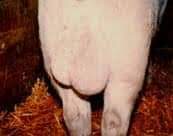Brucellosis in pigs
By- Dr Parvinder Kaur
Veterinary officer
NRDDL Jalandhar
9814652576
B suis is usually spread mainly by ingestion of infected tissues or fluids. Infected boars may transmit the disease during service; the organism can be recovered from semen.
Pigs raised for breeding purposes are sources of infection. Suckling pigs may become infected from sows but most reach weanling age without becoming infected.
After exposure to B suis, pigs develop a bacteremia that may persist for as long as 90 days. During and after the bacteremia, localization may occur in various tissues. Signs depend considerably on the site(s) of localization. Common manifestations are abortion, temporary or permanent sterility, orchitis, lameness, posterior paralysis, spondylitis, and occasionally metritis and abscess formation.
The incidence of abortion may be 0–80%. Abortions may also occur early in gestation and be undetected. Usually, sows or gilts that abort early in gestation return to estrus soon afterward and are rebred.
Sterility in sows, gilts, and boars is common and may be the only manifestation. Before attempting treatment for other diseases, it is logical to test for brucellosis in herds in which sterility is a problem. Sterility in sows is more frequently temporary but may be permanent. In boars, orchitis, usually unilateral, may occur, and fertility appears to be reduced.
Diagnosis
The principal means of diagnosis in pigs is the brucellosis card (rose bengal) test; however, other serum agglutination tests or complement fixation tests have been used. It is generally accepted that the tests have limitations in detecting brucellosis in individual pigs. Thus, entire herds or units of herds, rather than individual pigs, must be tested in any control program. Low agglutinin titers are seen in almost any size herd, regardless of infection status, and a few infected pigs may have no detectable titer. The card test is usually more accurate than conventional agglutination tests. Supplemental tests designed for cattle may also be used for pigs.
Prevention and control
Caution should be practiced in the purchase of individual pigs that exhibit a low agglutinin titer unless the status of the entire herd of origin is known. Pigs should be isolated on return from fairs or shows before reentering the herd. Replacements should be purchased from herds known to be free of brucellosis, or they should be tested and isolated for 3 mo and retested before being added to the herd.
There is no vaccine for brucellosis in swine, and no practical recommendations can be made for treatment. Control is based on test and segregation as well as slaughter of infected breeding stock. Brucellosis remains a problem in feral swine and is a potential source of infection for domesticated herds and people.



